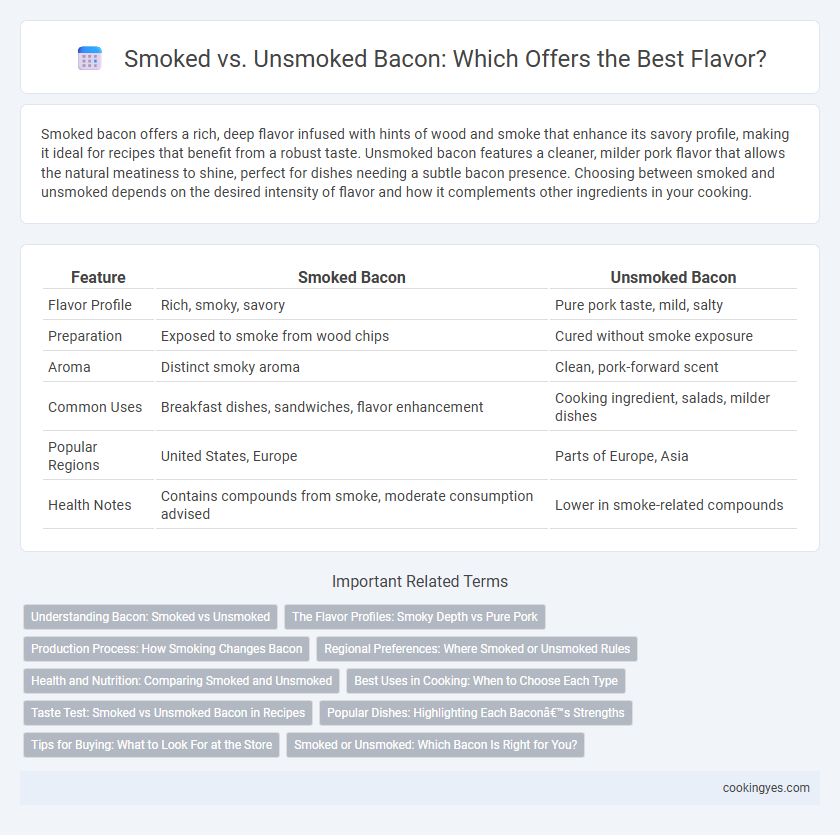Smoked bacon offers a rich, deep flavor infused with hints of wood and smoke that enhance its savory profile, making it ideal for recipes that benefit from a robust taste. Unsmoked bacon features a cleaner, milder pork flavor that allows the natural meatiness to shine, perfect for dishes needing a subtle bacon presence. Choosing between smoked and unsmoked depends on the desired intensity of flavor and how it complements other ingredients in your cooking.
Table of Comparison
| Feature | Smoked Bacon | Unsmoked Bacon |
|---|---|---|
| Flavor Profile | Rich, smoky, savory | Pure pork taste, mild, salty |
| Preparation | Exposed to smoke from wood chips | Cured without smoke exposure |
| Aroma | Distinct smoky aroma | Clean, pork-forward scent |
| Common Uses | Breakfast dishes, sandwiches, flavor enhancement | Cooking ingredient, salads, milder dishes |
| Popular Regions | United States, Europe | Parts of Europe, Asia |
| Health Notes | Contains compounds from smoke, moderate consumption advised | Lower in smoke-related compounds |
Understanding Bacon: Smoked vs Unsmoked
Smoked bacon delivers a rich, smoky flavor profile derived from wood smoke curing, which enhances its savory depth and complexity. Unsmoked bacon retains the natural pork flavors with a cleaner, milder taste, often preferred in recipes requiring less intense seasoning. Understanding the difference in curing methods helps in selecting bacon varieties to complement specific culinary applications and desired flavor outcomes.
The Flavor Profiles: Smoky Depth vs Pure Pork
Smoked bacon delivers a rich, smoky depth with complex layers of wood-fired flavors that enhance savory notes and provide a slightly charred aroma. Unsmoked bacon preserves the pure pork taste, highlighting natural sweetness and meaty richness without any smoky undertones. Choosing smoked versus unsmoked bacon depends on whether you prefer a bold, aromatic complexity or a clean, straightforward pork flavor.
Production Process: How Smoking Changes Bacon
Smoking bacon involves curing pork belly with salt and spices, then exposing it to smoke from burning wood, which infuses the meat with distinctive smoky compounds like phenols and carbonyls. This process not only enhances flavor complexity but also contributes to preservation by reducing moisture and inhibiting bacterial growth. Unsmoked bacon, often referred to as green or fresh bacon, lacks these smoky flavor notes and typically has a milder, salt-cured taste due to the absence of wood smoke exposure.
Regional Preferences: Where Smoked or Unsmoked Rules
In the United States, smoked bacon dominates, especially in the South and Midwest, where hickory and applewood smokes enhance the rich, savory flavor profile preferred by consumers. Conversely, in parts of Europe such as Italy and France, unsmoked bacon or pancetta is favored, offering a milder, more natural pork taste that complements regional culinary traditions. Regional preferences are deeply influenced by local smoking techniques, cultural heritage, and typical recipes, shaping distinct flavor profiles in smoked versus unsmoked bacon varieties.
Health and Nutrition: Comparing Smoked and Unsmoked
Smoked bacon contains compounds from the smoking process, such as polycyclic aromatic hydrocarbons (PAHs), which may pose health risks if consumed excessively, while unsmoked bacon typically lacks these harmful substances. Nutritionally, both smoked and unsmoked bacon provide similar amounts of protein, fat, and calories, but smoked varieties often have added sodium due to curing methods. Choosing unsmoked bacon can reduce exposure to potential carcinogens, making it a preferable option for health-conscious consumers seeking bacon flavor without compromising nutrition.
Best Uses in Cooking: When to Choose Each Type
Smoked bacon offers a rich, intense flavor ideal for dishes like carbonara, sandwiches, and breakfast platters, where its deep aroma enhances the overall taste. Unsmoked bacon delivers a purer pork flavor with a saltier profile, making it perfect for recipes requiring subtlety, such as quiches, salads, or delicate soups. Choosing smoked or unsmoked bacon depends on whether the dish benefits from bold smokiness or a cleaner, straightforward pork essence.
Taste Test: Smoked vs Unsmoked Bacon in Recipes
Smoked bacon delivers a rich, savory flavor with hints of hickory or applewood, enhancing dishes like breakfast sandwiches and pasta carbonara with its deep, smoky aroma. Unsmoked bacon offers a cleaner, more natural pork taste, making it ideal for recipes where a lighter, milder bacon essence is preferred, such as salads or quiches. Taste tests reveal that smoked bacon generally provides a bolder flavor profile, while unsmoked bacon allows other ingredients to shine without overpowering the dish.
Popular Dishes: Highlighting Each Bacon’s Strengths
Smoked bacon brings a rich, smoky depth to dishes like BLTs and carbonara, where its bold flavor enhances the savory profile. Unsmoked bacon offers a cleaner, pork-forward taste ideal for recipes requiring subtle bacon presence, such as quiches or salads. Each type's unique flavor profile complements different culinary applications, making smoked bacon perfect for robust taste and unmasked bacon for delicate, nuanced dishes.
Tips for Buying: What to Look For at the Store
When buying bacon, check the label to identify smoked or unsmoked varieties, as smoked bacon delivers a rich, smoky flavor from wood smoke, while unsmoked offers a pure, natural pork taste. Look for bacon with a balanced fat-to-meat ratio and minimal additives or preservatives to ensure optimal flavor and quality. Choosing nitrate-free options or those cured with natural ingredients can enhance taste and provide a healthier option.
Smoked or Unsmoked: Which Bacon Is Right for You?
Smoked bacon offers a rich, deep flavor profile infused with wood smoke, enhancing dishes with its savory and slightly sweet notes, ideal for those who enjoy robust tastes. Unsmoked bacon provides a cleaner, more natural pork flavor with a subtle saltiness, making it versatile for recipes where the bacon taste should be mild and not overpower other ingredients. Choosing between smoked and unsmoked bacon depends on whether you prefer bold smokiness or a pure pork essence to complement your culinary creations.
Smoked vs Unsmoked for Bacon Flavor Infographic

 cookingyes.com
cookingyes.com